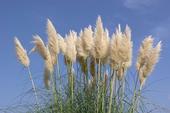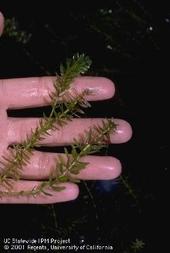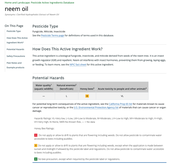- Author: Belinda Messenger-Sikes

Pesticides and fertilizers applied around homes, residential or commercial landscapes, school sites, and other areas can enter our creeks, rivers, and oceans, degrading water quality. While pesticides and fertilizers can be useful in controlling pests and helping plants grow, their overuse and misuse can harm the environment and human health.
To find out more, see our updated pages on urban pesticides, fertilizers, and water quality. These pages feature plain language definitions of toxicity and water quality and explanations of how pesticides and fertilizers get into our waterways. There's also information about how you can protect our creeks, rivers, and oceans when managing your home and landscape.
Learn about urban...

What you do with firewood this upcoming 4th of July (and year-round!) can impact more than just the s'mores on your campfire. If you move firewood around the state, you could spread deadly plant diseases and invasive insects. Don't take firewood with you if you travel or camp this holiday weekend.
Bringing firewood from home, even dry, aged, and seasoned wood, can spread pests. Once you arrive at your destination, pests can emerge from the firewood and spread to the surrounding area. Invasive pests like the emerald ash borer, shothole borers, and
- Author: Lauren Fordyce

Pampasgrass (Cortaderia selloana) is a common ornamental landscape plant that readily naturalizes throughout California's coastal areas and some interior regions. Historically, pampasgrass was planted for erosion control, but it has since escaped cultivation and spread along sandy, moist ditch banks throughout coastal regions of southern California. Pampagrass can also grow in the hot, dry climate of inland areas of California.
A similar-looking invasive grass, jubatagrass (Cortaderia jubata), is more widespread, aggressive, and is a major pest in coastal redwood forest areas. Jubatagrass thrives in cool, foggy environments and does not tolerate temperature extremes or...
- Author: Lauren Fordyce

Hydrilla (Hydrilla verticillata) is an invasive, aquatic weed that can be found in many slow-moving fresh water bodies in California. The plant forms large mats that can crowd out native plants, restrict water flow, and interfere with boating and fishing. These mats can reduce habitat for fish and other wildlife, degrade water quality, and increase the risk of flooding.
Hydrilla is easily spread since it often breaks apart into tiny pieces that can each produce new plants. It also produces special survival structures on the stems (turions) and in the sediment (tubers). Each tuber can produce a new plant. The tubers can survive up to seven years in the sediment before sprouting, even if no water is...
- Author: Lauren Fordyce

The University of California Statewide IPM Program (UC IPM) has an exciting, newly updated resource to help you better understand pesticide active ingredients and the risks different active ingredients pose to people and the environment.
The Pesticide Active Ingredient Database is designed for urban audiences including the general public, Master Gardeners, nursery and garden center staff, pest control operators, landscapers, and more. The active ingredients included in this database can be found in many commonly available pesticide products in California. The database contains a variety of pesticide types, including...


